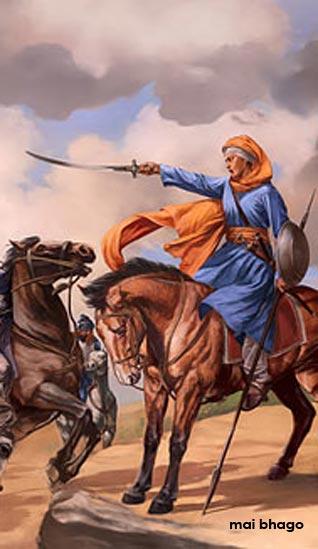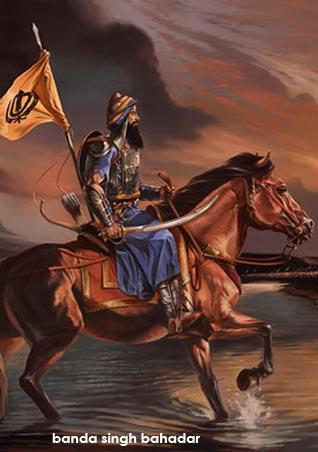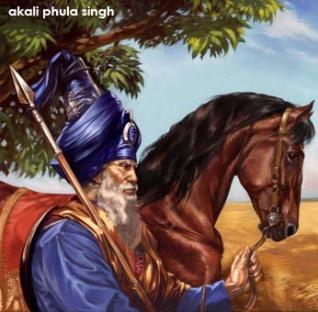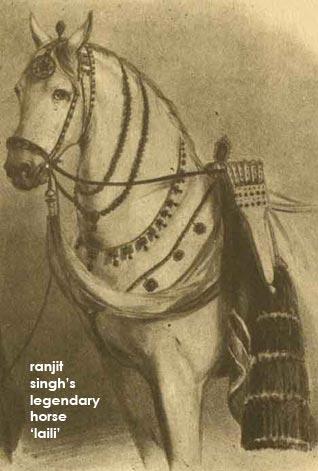
All images (except the portrait of Laili below) are details from paintings by Canadian artist Kanwar Singh (ArtofPunjab.com).



Columnists
A Man and His Horse
by I.J. SINGH
Not so long ago at the Sikh festival of Hola Mohalla an electrifying site caught the eye. Nihangs - traditional Sikh warriors - riding seemingly recklessly through the Punjabi countryside on their horses; a picture of breakneck speed and uncontrolled risk but, in fact, absolute breath-taking control. Legendary legerdemain!
Awaiting us is a saga ranging from the blue steed of Guru Gobind Singh to the overfed, obese, Sikhs spilling over their scooters, their glutei framing and overflowing the saddles. Mastering a spirited horse speaks of courage and valor that is decidedly not associated with gunning a scooter or a car.
A galloping horse has nobility and its rider automatically acquires an aura of it along with unquestionable elegance. It brings out the romantic in us all. It speaks of adventure and imagination - new lands to see and conquer; a new life, a fresh start, hope and dreams.
A horse was for eons, and remains even today, the embodiment of strength, grace and speed. There was a time in much of the world when a horse was the way to travel. Since only as recently as the last century we have replaced the horse with the automobile whose elegance is still measured by a mustang, its strength by horse-power. The cavalry has long been replaced by sturdier armored tanks, but generals around the world still ride horses when they inspect their soldiers.
The legend of the man and his horse will continue to live in the minds and lives of many an urban cowboy. Just tune into American country music or explore the mystique of the West via the movies of John Wayne.
Of all animals domesticated by man the horse is probably the most aristocratic. It has had a most powerful impact on human society perhaps for as long as 4000 years. We are not quite sure where it was first domesticated but horse driven chariots and cavalry perhaps were the first great revolutionary advances in the technology of human warfare in India, Middle East and China,
among others.
The horse's impact on agriculture and industry cannot be overestimated. Beyond the battlefield, horsepower also afforded great advances in transport, agriculture, industry, and science. The horse was likely a most significant instrument in the rapidity of communication and transmission of new knowledge - languages and science - across the world.
Yet, today we might think of that period as laboriously slow.
In the post-Columbus period, peoples and cultures were often rated on how they used the horse in society. The horse was likely a defining factor in the conquest by the Spanish of the horseless Americas. We refer interested readers to Pita Kelekna's wonderful 2009 book on "The Horse in Human History."
There was a time in India when it was ruled by Islamic despots and the ordinary non-Muslim was forbidden to ride a horse.
Quite expectedly, the Sikhs rebelled against such coercive edicts. They rode horses and raised an army during the time of the last five Gurus - from Guru Hargobind to Guru Gobind Singh. Understanding the needs of the times, the Gurus even asked their followers to donate horses and arms. If Sikhs are today a nation, then horses had a pivotal role to play in arriving there.
Sikh lore speaks of a heroic time when Sikhs lived their lives on horseback, traveled fast and furiously over risky terrain to snipe at vastly superior armies and then, as lightning, disappear into the impenetrable jungles from which they had emerged. History tells us that this is how Sikhs liberated the many young women of India who were being abducted into slavery by the
yearly invaders from beyond India's borders in the 17th and 18th centuries.
When Nadir Shah, the legendary invader who suffered repeatedly from Sikhs sniping at him found out about their intrepid lifestyle, he reportedly sighed and predicted that such warriors would surely one day rule their land. And he was right.
The steed that Guru Gobind Singh favored has come to occupy a unique place in the hearts and minds of Sikhs. Lore tells us that it was a rare blue in color. We haven't seen much on it in written or oral records.
It may be time for some enterprising Sikh scholar to explore in detail the role of the Horse in Sikh history.
ijsingh99@gmail.com
December 31, 2010
Conversation about this article
1: Harmeet Singh (U.S.A.), December 31, 2010, 7:37 PM.
I really admire I.J. Singh's insight into the role of horses in our history. The Sikh Cavalry was an important part of the Sikh armies, and the role played by them is inscribed in gold in history. Sikhs commanded excellent horsemanship that led them to rule their own land. The breaking of the Sikh Horse was therefore vital for the English in the Anglo-Sikh Wars. I am interested to know about the significance of the horse at Sikh weddings. What is the earliest record of inclusion of the horse in the wedding ceremony?
2: Ari Singh (Burgas, Bulgaria), January 01, 2011, 3:43 AM.
Thank you for a very interesting article. My daughter, Anita Aradottir, is a horse tamer, trainer, dealer and winner of many trophies in Iceland and one of the few trained by Monty Rogers. Horse riding is the main sport in Iceland, the land of Vikings. Incidentally, Iceland still preserves the purest form of the Viking langauge, the language of some of the most feared warriors in European history. Their langauge is related to Punjabi and so are their customs and foods (roti, salty paaparrs, etc). I call them the Sikhs of Europe! It is interesting to note that the Vikings lost their ferocity soon after they converted to Christanity and the Viking raids into England, Scotland and Ireland (from where they got their slaves) stopped as well. They were dependent on their boats and horses. The Viking horse was unique and sturdy and comfortable to ride (they have a special gait for comfort).
3: Sangat Singh (Kuala Lumpur, Malaysia), January 01, 2011, 4:37 PM.
My career as a horseman was doomed in about five minutes. As a kid of about 12, I was dared to ride a pony, and had me propped up when it shot off like a bullet. I was terrified and didn't know where the brakes were, but luckily it ran out of gas and stopped on its own volition. Since horses have been the principal mode of transport for both civilians and the military, our history is replete with stories of horses. The two famous horses Dil Bagh and Gul Bagh, gifts to Guru Hargobind, were seized by the Mughal Emperor's officials when Bidhi Chand, an erstwhile highwayman and robber of note, who had now become a Guru's Sikh, was pressed into service. He successfully retrieved the Guru's horses. Then of course was Guru Gobind Singh's famous Neela. Maharaja Ranjit Singh had a passion for horses and even fought a battle to possess the famous Laili that cost him 12,000 soldiers and 6 million rupees for the legendary horse of the time. When it entered Lahore for the first time, it equaled a bridal procession and Laili was decorated with the world's costliest jewels, including the Koh-I Noor. The court poet Qadir Yar even composed a poem in praise of Laili. A few years later, when Leili died, the Maharaja wept inconsolably and the steed was given a state burial with a 21-gun salute. Such was the Maharaja's passion for horses. This is the story of The Man and His Horse.
4: K. Singh (Massachusetts, U.S.A.), January 04, 2011, 10:25 AM.
An attempt to answer Harmeet Singh's question: As far as I know, the horse does not have any connection to a Sikh wedding, this is more of a ancient ritual that has become a standard in the Sikh Anand Karaj. In olden days, the groom's party would travel to the girl's home, which could be far away, and the groom would ride on a horse to get there while the rest of the party walked. With the hi-fi cars and all we use now, this is not needed, and it is now more show than anything.


